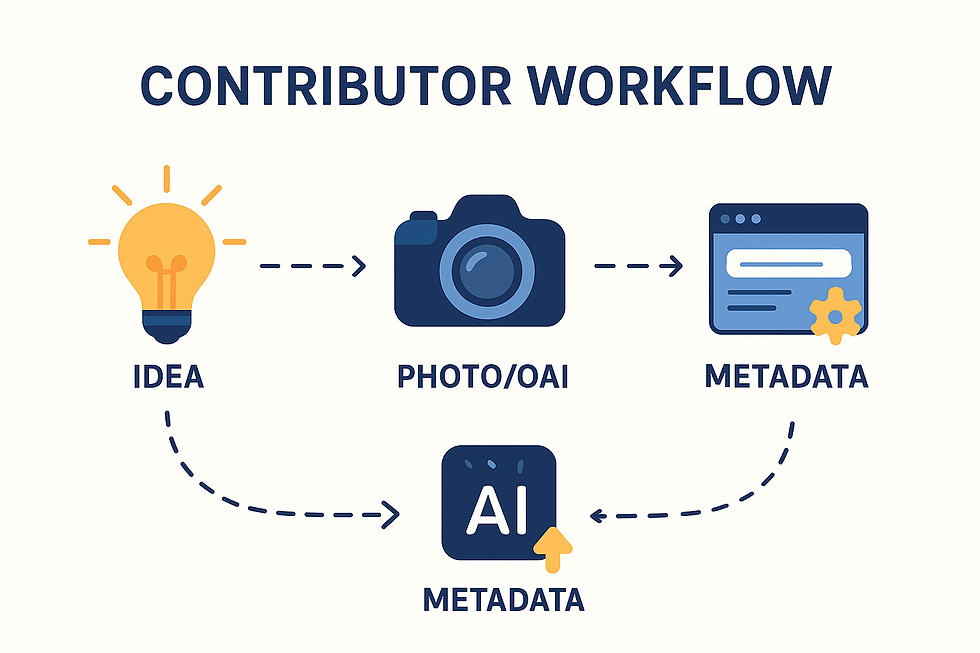8 Tips to Optimize Your Shutterstock Portfolio for SEO
- Nikhil Garg
- Aug 24
- 7 min read
Introduction
In today’s competitive stock photography world, simply uploading beautiful images or creative illustrations isn’t enough. With over 600 million files available on Shutterstock, buyers rely heavily on search to find what they need. This is where SEO (Search Engine Optimization) plays a crucial role.
Think of your Shutterstock portfolio like a website: if your files don’t appear in search results, they may never get noticed — no matter how good they are. That’s why mastering Shutterstock SEO is essential for every contributor in 2025.

By learning how to write strong titles, craft detailed descriptions, choose effective keywords, and organize your content, you can dramatically improve your visibility, increase downloads, and build a consistent income stream. This blog explores 8 actionable Shutterstock SEO tips every contributor should follow, plus a look at the future of SEO in stock photography.
1. Craft Strong, Keyword-Rich Titles
Your image title is the first SEO signal Shutterstock’s search engine evaluates. Instead of generic titles like “Dog”, write descriptive ones like “Happy Golden Retriever Playing Fetch in Park”. This not only improves ranking but also tells buyers exactly what they’re getting.
Best practice: Keep titles between 5–10 words.
Include context: Add activity, setting, or mood (e.g., “Smiling Business Team in Modern Office Meeting”).
Mistake to avoid: Don’t stuff keywords like “dog puppy animal pet canine park” — this looks spammy and reduces visibility.

2. Write Compelling, Detailed Descriptions
Descriptions help buyers (and the algorithm) understand your content. Think of it as the story behind your photo. A good description goes beyond keywords to provide context.
Example: Instead of “Family dinner”, write “Happy multigenerational family enjoying festive dinner at home, laughing and sharing food around the dining table.”
Pro tip: Write 2–3 sentences, weaving in primary and secondary keywords naturally.
Mistake to avoid: Copy-pasting the title into the description—this wastes SEO potential.

📎 Keyword planner for entire year
Packed with actionable tips for Shutterstock success, niche ideas, and automation tools for contributors.
3. Do Smart Keyword Research
Keywords are the backbone of Shutterstock SEO. Without them, buyers won’t find your images. Use keyword research tools like Shutterstock Keyword Tool, Google Trends, or competitor portfolios to identify terms people are actively searching.
Mini-step: Search your subject on Shutterstock and note the top 10 keywords used in best-selling images.
Balance broad & specific terms: For example, use “remote work” but also “young professional working from home on laptop.”
Mistake to avoid: Adding irrelevant keywords just to gain clicks — buyers will skip your images if they don’t match the search intent.

(Step-by-Step Guide)
Open Shutterstock Keyword Tool → Go to Shutterstock Keyword Tool.
Enter Your Subject → Type your main subject (e.g., remote work).

“Shutterstock Keyword Tool results for the keyword ‘Coffee’.” Analyze Top Keywords → Review the top 10–20 keywords Shutterstock suggests.
Cross-check with Google Trends → Validate demand by checking keyword popularity on Google Trends.

“Google Trends graph comparing keyword popularity over time for ‘Coffee’.” Study Competitors → Look at best-selling images in your category and note recurring keywords.
Refine Your List → Balance broad terms (“remote work”) with specific terms (“young professional on laptop at home”).
Apply to Metadata → Use these keywords in your title, description, and tags without stuffing.
Pro Tip: Keep a personal keyword bank (Google Sheet/Notion table) so you can reuse strong keywords across uploads.
4. Mix Long-Tail and Short Keywords
Short keywords (e.g., “cat”) are competitive but bring traffic. Long-tail keywords (e.g., “tabby cat sleeping on cozy sofa”) are less competitive and bring more qualified buyers. The best portfolios strike a balance.
Strategy: Use 2–3 broad keywords + 5–6 long-tail keywords in every upload.
Why it works: Long-tail keywords often reflect buyer intent, which means higher conversion rates.
Mistake to avoid: Using only broad terms—your work will get buried among millions of results.

5. Focus on Buyer-Intent Tags
Think like a buyer. Ask yourself: What would someone search before purchasing this photo? Adding commercial or editorial intent keywords can make all the difference.
Example: Instead of just “laptop,” tag as “remote work office laptop student studying”.
Pro tip: Think about the use case — ad campaigns, blog headers, presentations, etc.
Mistake to avoid: Adding generic tags with no buyer context, like “nice,” “cool,” or “image.”

(Step-by-Step Guide)
Think Like a Buyer → Ask: What exact use case could this image fulfill?
Use Shutterstock Search Bar → Type your keyword (e.g., laptop) and see autocomplete suggestions (e.g., remote work laptop student).

“Shutterstock autocomplete suggestions for the keyword ‘laptop’.” Add Commercial/Editorial Context → Instead of “laptop,” tag as “remote work office laptop studying student.”
Use Long-Tail Tags → Add specific tags like “virtual team meeting on Zoom” rather than just “meeting.”
Validate Buyer Intent → Check related searches in Shutterstock or competitor sites.
Test and Adjust → After upload, monitor impressions and clicks in your Shutterstock contributor dashboard.

“Shutterstock Contributor Dashboard showing impressions and clicks by keyword tags.” Remove Weak Tags → If a tag isn’t driving traffic after 2–3 months, replace it with stronger ones.
Pro Tip: Always tag with the end-use case in mind (advertising, editorial, presentation, blog header).
📎 Keyword planner for entire year
Packed with actionable tips for Shutterstock success, niche ideas, and automation tools for contributors.
6. Organize Your Portfolio into Themes
Buyers often purchase multiple related images for consistency in campaigns. Grouping your portfolio into themes like “Travel,” “Food,” “Business,” makes it easier for them to explore and buy more.
Strategy: Upload series (e.g., 10 images of the same travel location, but different angles).
SEO Boost: The algorithm favors portfolios with strong themed clusters.
Mistake to avoid: Uploading random images without structure—it dilutes your portfolio’s authority.

7. Balance Trends with Evergreen Content
Trends bring quick downloads, while evergreen content delivers long-term sales. Smart contributors do both.
Trends example: “AI in the workplace” or “Metaverse team meeting.”
Evergreen example: “Students studying in classroom” or “Sunset over ocean.”
Pro tip: Dedicate 30% of your uploads to trends and 70% to evergreen to balance short-term and long-term income.
Mistake to avoid: Chasing only trends—once demand fades, your portfolio loses relevance.

8. Monitor Analytics and Adapt
Shutterstock gives contributors valuable insights—downloads, views, and search data. Use this data to refine your strategy.
Mini-step: Review which keywords lead to the most downloads and replicate those in new uploads.
Adapt fast: If one subject sells better, create variations and expand into related themes.
Mistake to avoid: Ignoring analytics and continuing to upload blindly—this wastes time and reduces earning potential.

What Contributors Should Keep in Mind
Avoid spamming keywords — it lowers ranking.
Stay authentic — Shutterstock buyers prefer real, relatable content.
Always follow Shutterstock’s submission guidelines.
Think commercially: ask yourself, “How could a buyer use this image?” before uploading.

📎 Keyword planner for entire year
Packed with actionable tips for Shutterstock success, niche ideas, and automation tools for contributors.
The Future of Shutterstock SEO
Shutterstock SEO in the coming years will be shaped by AI-driven search engines and buyer personalization. Instead of relying solely on keywords, algorithms will increasingly analyze:
Visual similarity (AI recognizing objects, moods, and styles).
Buyer behavior (previous downloads, niche preferences).
Voice and natural language searches (e.g., “photos of happy families celebrating Diwali”).
Contributors should prepare for this shift by:
Uploading authentic, context-rich visuals.
Using storytelling keywords (not just object-based tags).
Keeping portfolios updated with trends to match AI recommendations.
The future belongs to contributors who blend SEO strategies with AI-readiness.

TL;DR (Too Long; Didn’t Read)
Use clear titles & descriptions.
Do keyword research with intent in mind.
Balance long-tail & short keywords.
Organize content into collections.
Mix trend-driven & evergreen files.
Monitor analytics & keep adapting.

Conclusion
Mastering Shutterstock SEO is no longer optional — it’s the foundation of success in 2025. With smarter titles, optimized descriptions, researched keywords, and future-ready strategies, your portfolio can stand out in a crowded marketplace.
Remember, SEO is not a one-time activity but a continuous process of refinement and adaptation. Those who invest in it today will enjoy higher visibility, more downloads, and long-term success tomorrow.

FAQs| Shutterstock SEO Tips
Q1. How many keywords should I use on Shutterstock?
Shutterstock allows up to 50 keywords per file, but using 30–40 highly relevant ones is ideal.
Q2. Should I repeat words from the title in the keywords?
Yes, but don’t overdo it. Repetition should feel natural, not forced.
Q3. Can I edit titles and keywords after uploading?
Yes, you can always update titles, descriptions, and keywords to improve SEO.
Q4. What are the best tools for Shutterstock SEO?
Shutterstock Keyword Tool, Google Trends, and competitor analysis are the most effective.
Q5. Does Shutterstock SEO help on Google too?
Yes — well-optimized titles and descriptions can also make your images rank on Google Images.
📎 Keyword planner for entire year
Packed with actionable tips for Shutterstock success, niche ideas, and automation tools for contributors.



Comments